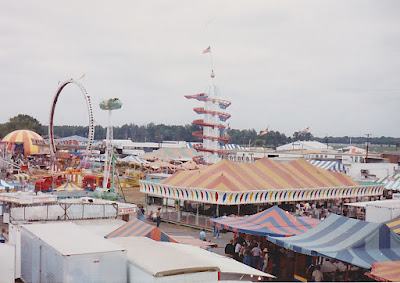My first tango with this gentle giant happened way back in the mid-to-late 80s at the Pensacola Interstate Fair. Picture this: a wide-eyed, slightly apprehensive little me, being coaxed onto this behemoth by my brave big sister, Becki. Now, the exact ownership is a bit hazy in my mind – maybe it was the legendary Gooding's Million Dollar Midways, who held the contract back then? What I do remember, vividly, was seeing something on the news about this particular Enterprise being a vintage import from Bremen, Germany, dating all the way back to 1976! How cool is that?
I didn't know what to expect even though I saw it in action many times. But then the ride started. Oh, that sound! That deep, guttural hum of the motor as it began to spin. For anyone who's ever loved an Enterprise, or any of those beautifully engineered Huss rides, that sound alone is iconic. It's the mechanical heartbeat of pure, unadulterated fun. And then, the magic began. A little jolt, a gentle sway, and then the entire arm of the ride started its graceful ascent. Suddenly, we weren't just spinning; we were flying.
You hop into your individual car, and that's when the first-timers usually have a mini-panic attack: "Where in the Sam Hill is the seatbelt?!" Fear not, my friends! You don't need one. What you do need is that door. Depending on the model, it either slides securely shut or flips down with a reassuring clunk. Some even have a backup chain, just for that extra layer of "you're not going anywhere" security.
Now, for the real nerds (like me!), let's talk manufacturers. While there were a few players in the Enterprise game, the two titans were undoubtedly Schwarzkopf and Huss. Interestingly, they both rolled out their versions in the same year: 1972, with Schwarzkopf actually being the first to design and build it. Here in the US, when it comes to the traveling Enterprises I've had the pleasure of experiencing, almost all of them have been Huss beauties. I'm talking about the ones owned by Gooding's and Reithoffer, of course, but also the Conklin Shows machine, the Murphy Brothers' ride, and even the one Drew Shows spiffed up and then quickly passed on to Deggellar.
The Schwarzkopf Enterprises? Those were more of a park fixture, at least in my experience. I definitely remember riding one at Six Flags Over Texas, and who could forget the iconic "Wheelie" at Six Flags Over Georgia? The news of its removal and subsequent move to Fun Spot America in Orlando was a sad day for many Atlanta-area thrill-seekers. I've heard so many "Wheelie" fans holding out hope for its return, maybe even to the Fun Spot Atlanta location down in Fayetteville. Fingers crossed! As for other park models, like the ones at King's Island and Six Flags Great Adventure, the manufacturer details are a bit fuzzy in my memory banks.
Sadly, the days of the traveling Enterprise seem to be dwindling a bit here in the States. The cost of keeping these magnificent machines in tip-top shape is no joke, and many have been retired or found new homes in parks or shows overseas. But here's a little tidbit that blew my mind: apparently, owners of the Huss Enterprise models had the option to convert them to run backwards! Can you even imagine? According to a Huss service letter from 1984, North American Parts Inc. offered this conversion. A backwards Enterprise… part of me is dying to try it, and the other part is convinced my aforementioned mama-induced fear of upside-down-induced nausea would kick into overdrive! Wouldn't it be absolutely insane if the cars faced each other, and halfway through the ride, it just stopped and reversed direction? It'd be like a Sky Diver, but without that tempting steering wheel!
So, there you have it – my personal journey with the Enterprise. It's a ride that embodies the thrill and nostalgia of the carnival for me. That unique sound, the anticipation as you rise skyward, the brief moment of weightlessness as you hang upside down… it's pure magic.
What about you? Do you have any Enterprise stories? Any memories of riding one, good or bad (though hopefully more good than bad!)? I'd absolutely love to hear your experiences in the comments below! And hey, while we're reminiscing about these incredible rides and the joy they bring, if you've enjoyed this little trip down memory lane with me and want to help fuel more of these nostalgic deep dives (maybe even contribute to my future carnival adventures!), well, let's just say virtual high-fives and any little tokens of appreciation are always warmly welcomed. Just sayin'! 😉
https://www.facebook.com/adrianduarte
https://bsky.app/profile/adriansknitwits.bsky.social
https://www.instagram.com/adriansknitwits
https://www.threads.net/adriansknitwits



.jpeg)
.jpeg)


















